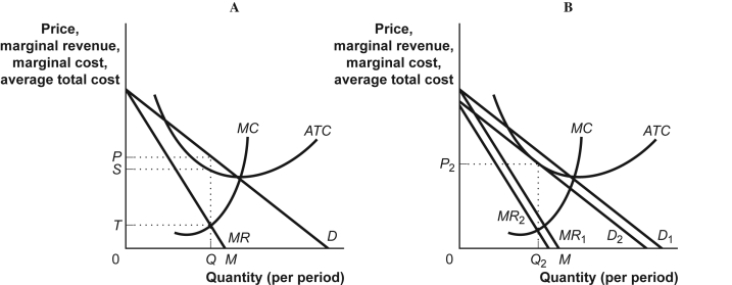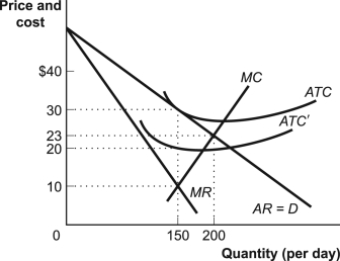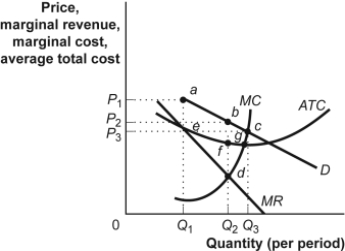A) equal to marginal
B) greater than marginal
C) less than marginal
D) greater than total
Correct Answer

verified
Correct Answer
verified
Multiple Choice
Critics of advertising argue that it:
A) tends to make markets more perfect.
B) leads to low-cost mass production.
C) results in higher prices to consumers.
D) encourages competition through new-product advertising.
Correct Answer

verified
Correct Answer
verified
Multiple Choice
In monopolistic competition:
A) firms earn zero economic profits in the long run.
B) each firm produces a product identical to that of every other firm in the industry.
C) firms are aware of their strategic interdependence.
D) firms earn large economic profits in the long run.
Correct Answer

verified
Correct Answer
verified
Multiple Choice
A(n) _____ market has a single firm and _____,whereas a(n) _____ market has _____ firm(s) and _____.
A) oligopolistic;no barriers to entry;monopolistic;many;easy entry and exit
B) monopolistic;barriers to entry;monopolistically competitive;many;easy entry and exit
C) monopolistic;barriers to entry;oligopolistic;few;no barriers to entry
D) monopolistically competitive;barriers to entry;monopolistic;one;barriers to entry
Correct Answer

verified
Correct Answer
verified
True/False
Gas stations are not monopolistically competitive because everyone knows the gasoline is the same,regardless of where it is purchased.
Correct Answer

verified
Correct Answer
verified
Multiple Choice
In a monopolistically competitive industry:
A) a firm maximizes profits when MR = MC yet P > MC.
B) people would be better off if output were reduced.
C) output could be increased without an increase in total cost.
D) to maximize profits,firms set MR = MC,and people would be better off if output were reduced.
Correct Answer

verified
Correct Answer
verified
Multiple Choice
Use the following to answer question:
Figure: Profits in Monopolistic Competition  -(Figure: Profits in Monopolistic Competition) Use Figure: Profits in Monopolistic Competition.In panel (A) of the figure,the profit-maximizing quantity of output is determined by the intersection at point:
-(Figure: Profits in Monopolistic Competition) Use Figure: Profits in Monopolistic Competition.In panel (A) of the figure,the profit-maximizing quantity of output is determined by the intersection at point:
A) G.
B) F.
C) H.
D) C.
Correct Answer

verified
Correct Answer
verified
Multiple Choice
Monopolistic competition is characterized by:
A) free entry and exit in the long run.
B) each firm producing a standardized product.
C) few producers.
D) barriers to entry.
Correct Answer

verified
Correct Answer
verified
Multiple Choice
The problem of wasteful duplication in monopolistic competition is due to:
A) excess capacity.
B) a lack of physical and human capital.
C) barriers to entry.
D) the lack of close substitutes for products produced by monopolistically competitive firms.
Correct Answer

verified
Correct Answer
verified
Multiple Choice
The _____ demand curve for a firm operating in a monopolistically competitive market _____ facing a perfectly competitive firm.
A) downward-sloping;is the same as the demand curve
B) downward-sloping;differs from the horizontal demand curve
C) horizontal;differs from the downward-sloping demand curve
D) horizontal;is the same as the demand curve
Correct Answer

verified
Correct Answer
verified
True/False
Competition limits the price a monopolistically competitive firm can set.
Correct Answer

verified
Correct Answer
verified
Multiple Choice
Defenders of advertising argue that it:
A) seeks to persuade,rather than inform,buyers.
B) provides education and information about products.
C) facilitates the concentration of monopoly power.
D) encourages artificial product differentiation.
Correct Answer

verified
Correct Answer
verified
Multiple Choice
Which statement about advertising is TRUE?
A) There is no role for advertising in perfect competition.
B) Firms in monopolistic competition and oligopoly use advertising without the expectation of increasing profit.
C) Advertising has costs but few if any benefits.
D) Advertising is critical in the long run but not the short run.
Correct Answer

verified
Correct Answer
verified
Multiple Choice
(Scenario: Monopolistically Competitive Firm) Use Scenario: Monopolistically Competitive Firm.Given the information in the scenario,what is the profit-maximizing level of output for this firm in the short run? Scenario: Monopolistically Competitive Firm For a monopolistically competitive firm,the demand curve is given by Q = 160 - P,and the firm's cost functions are: MC = 20 + 2Q and TC = 20Q + Q2 + 20.
A) 160 units
B) 20 units
C) 35 units
D) 180 units
Correct Answer

verified
Correct Answer
verified
Multiple Choice
Use the following to answer question:
Figure: Profit Maximization in Monopolistic Competition  -(Figure: Profit Maximization in Monopolistic Competition) Use Figure: Profit Maximization in Monopolistic Competition.In panel (A) of the figure,the profit-maximizing price and quantity are _____ and _____.
-(Figure: Profit Maximization in Monopolistic Competition) Use Figure: Profit Maximization in Monopolistic Competition.In panel (A) of the figure,the profit-maximizing price and quantity are _____ and _____.
A) S;M
B) P;M
C) P;Q
D) T;Q
Correct Answer

verified
Correct Answer
verified
Multiple Choice
Monopolistic competition describes an industry characterized by:
A) a product with no close substitutes.
B) many firms,each with some market power.
C) a small number of firms.
D) barriers to entry and exit.
Correct Answer

verified
Correct Answer
verified
Multiple Choice
Use the following to answer question:
Figure: Profit Maximization for a Firm in Monopolistic Competition  -(Figure: Profit Maximization for a Firm in Monopolistic Competition) Use Figure: Profit Maximization for a Firm in Monopolistic Competition.Suppose that an innovation reduces a firm's costs from ATC to ATC'.Before the innovation reduced the cost,the firm's economic profit at the profit-maximizing quantity was:
-(Figure: Profit Maximization for a Firm in Monopolistic Competition) Use Figure: Profit Maximization for a Firm in Monopolistic Competition.Suppose that an innovation reduces a firm's costs from ATC to ATC'.Before the innovation reduced the cost,the firm's economic profit at the profit-maximizing quantity was:
A) $0.
B) $30.
C) $750.
D) $4,500.
Correct Answer

verified
Correct Answer
verified
Multiple Choice
Use the following to answer question:
Figure: The Restaurant Market  -(Figure: The Restaurant Market) Use Figure: The Restaurant Market.The figure shows curves facing a typical restaurant.Assume that many firms,differentiated products,and easy entry and exit characterize the market.In the long run:
-(Figure: The Restaurant Market) Use Figure: The Restaurant Market.The figure shows curves facing a typical restaurant.Assume that many firms,differentiated products,and easy entry and exit characterize the market.In the long run:
A) restaurants will leave the market.
B) restaurants will enter the market.
C) restaurants will neither enter nor exit the market.
D) Not enough information is given to answer the question.
Correct Answer

verified
Correct Answer
verified
Multiple Choice
Monopolistic competition describes an industry characterized by:
A) a product with many close substitutes.
B) a horizontal demand curve.
C) a small number of firms.
D) barriers to entry and exit.
Correct Answer

verified
Correct Answer
verified
Multiple Choice
If a firm operating in monopolistic competition is producing a quantity at which _____,then the marginal decision rule tells us that profit _____.
A) MC > MR;can be increased by increasing production
B) MC < MR;can be increased by decreasing production
C) MC < MR;can be increased by increasing production
D) MC > MR;is maximized
Correct Answer

verified
Correct Answer
verified
Showing 101 - 120 of 245
Related Exams